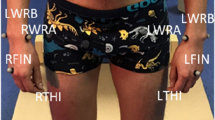Abstract
Purpose
Obstetric brachial plexus lesions (OBPL) are caused by the lesion or rupture of the cervical and thoracic nerves during birth. Physical therapy, based on ludic activities, can be useful to improve the OBPL treatment in children. This paper proposes a rehabilitation platform with a ludic interface (lights and sounds), using the magnitude motion gain of a user to aid in the OBPL treatment.
Methods
The motor development table (MDT) is an electronic platform composed of eight light segments (with green and red LEDs) that detect the touch of a child’s hand (by optic proximity sensors). Each touch generates a different sound, depending on the exercise. The physiotherapist can choose the MDT game, and the child score can be recorded. The operation of the rehabilitation platform was tested in relation to its behavior depending on the environmental lighting, its efficiency in data processing, and its maximum distance of drive. We also applied an opinion survey.
Results
The tests showed that the MDT can be used in environments with up to 1015 lx of illumination and that the incidence of high-intensity light affects the segments’ ability to detect the hand. In addition, the tests demonstrated that the behavior of this device is not affected by the number of errors or triggers performed during the exercises.
Conclusion
Based on these findings and on the opinion survey, it is possible to conclude that the MDT can reliably assist the physiotherapist in orthopedic management by providing feedback from the sessions and the patients’ temporal progress.



Similar content being viewed by others
References
Alberti EJ, Pichorim SF, Brawerman A (2012) Towards a motor ability training table for rehabilitating children with obstetric brachial plexus lesion. In Proceedings of the 2012 international conference on bioinformatics and computational biology. Las Vegas.
Bandy WD, Sanders B. Exercício Terapêuticos: Técnicas para Intervenção. 1st ed. Rio de Janeiro: Guanabara Koogan; 2001.
Bialocerkowski AE, Galea M. Journal of brachial plexus and comparison of visual and objective quantification of elbow and shoulder movement in children with obstetric brachial plexus palsy. J Brachial Plex Peripher Nerve Inj. 2006;6:5. https://doi.org/10.1186/1749-7221-1-Received.
Borschel GH, Clarke HM. Obstetrical brachial plexus palsy. Plast Reconstr Surg. 2009;124(1 Suppl):144e–55e. https://doi.org/10.1097/PRS.0b013e3181a80798.
Caldeira T, Santos M, Valente ET, Vilarinho A. Paralisia do Plexo Braquial. Prevalência e factores de risco. Acta Paediatr Port. 2010;41:8–10.
Campbell SK, Linden DWV, Palisano RJ. Physical therapy for children. 2nd ed. Philadelphia: W. B. Saunders Company; 2000.
Cruciani A, Germanotta M, Pecchioli C, Loreti S, Spedicato A, Meotti M, et al. Reliability, validity and discriminant ability of the instrumental indices provided by a novel planar robotic device for upper limb rehabilitation. J Neuroeng Rehabil. 2018;15(1):1–14. https://doi.org/10.1186/s12984-018-0385-8.
Da Gama A, Fallavollita P, Teichrieb V, Navab N. Motor rehabilitation using Kinect: a systematic review. Games Health J. 2015;4(2):123–35. https://doi.org/10.1089/g4h.2014.0047.
Germanotta M, Cruciani A, Di Sipio E, Pecchioli C, Aprile I, Padua L. Effects of a robotic rehabilitation treatment in a patient with traumatic lesion of the right brachial plexus measured by means of motion analysis: a case study. J Peripher Nerv Syst. 2018;23(2018):S17–8. https://doi.org/10.1016/j.gaitpost.2018.07.127.
Kliegman RM, Behrman RE, Jenson HB, Stanton BF. Nelson, tratado de pediatria (18th ed. Rio de Janeiro: Elsevier Inc; 2009.
Polden M, Mantle J. Fisioterapia em Ginecologia e Obstetrícia. 2nd ed. São paulo: Livraria Santos Editora Comp. Imp. Ltda; 2000.
Ratliffe KT. Fisioterapia na Clínica Pediátrica. 1st ed. São Paulo: Livraria Santos Editora Comp. Imp. Ltda; 2001.
Tachdjian MO. Ortopedia Pediátrica (1a). São Paulo: Manole Ltds; 1995.
Yu H, Xie L, Lv C, Shao W, Wang Y, Wang J, et al. A system for upper limb rehabilitation and motor function evaluation. J Mech Med Biol. 2015;15(01):1550010. https://doi.org/10.1142/S0219519415500104.
Author information
Authors and Affiliations
Corresponding author
Ethics declarations
The authors declare that they have no conflict of interest. All procedures performed in studies involving human participants were in accordance with the ethical standards of the institutional and/or national research committee and with the 1964 Helsinki declaration and its later amendments or comparable ethical standards. This survey was approved by the Ethical Committee of Federal University of Technology - Paraná (UTFPR) – Number 01519113.2.0000.5547.
Additional information
Publisher’s note
Springer Nature remains neutral with regard to jurisdictional claims in published maps and institutional affiliations.
Rights and permissions
About this article
Cite this article
Alberti, E.J., Pichorim, S.F. & Brawerman, A. An obstetric brachial plexus lesion rehabilitation platform. Res. Biomed. Eng. 35, 167–172 (2019). https://doi.org/10.1007/s42600-019-00018-x
Received:
Accepted:
Published:
Issue Date:
DOI: https://doi.org/10.1007/s42600-019-00018-x




